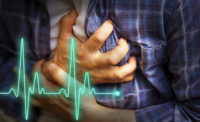Take Heart
Public access defibrillation saves lives

What is an AED?
An AED is a portable electronic device that automatically diagnoses life-threatening heart rhythms called Ventricular Fibrillation (V-Fib) and Ventricular Tachycardia (V-Tac). V-Fib is a useless quivering of the heart that doesn’t pump any blood and V-Tac is when the heart is beating too fast to fill and effectively pump enough blood to the body. Therefore, the victim has no palpable pulse and is “clinically dead” or in cardiac arrest.
An AED is able to recognize these arrhythmias and stop them with an electric shock, which then allows the heart to reestablish an effective pumping rhythm. This is called “defibrillation,” which means to “stop fibrillation.” Most people think these machines are designed to “jump-start” the heart when, in reality, they “stop” the heart and let the heart restart on its own or through the use of medicine.
When a victim’s heart rhythm has gone to a “flat-line” — also called “asystole” — an AED will not deliver a shock, because the heart has already stopped. When this occurs, the AED will tell the user to check circulation and start Cardio-Pulmonary Resuscitation (CPR).
Why do we need AEDs?
300,000 people die every year from heart disease, still the leading cause of death in the U.S. today. Survival from cardiac arrest decreases by 10 percent every minute without help. Most Emergency Medical Technicians (EMTs) are not even on scene to help within 10 minutes of the cardiac arrest. Without CPR, the brain can only last 10 minutes before complete brain damage occurs (also called “biological death”), although special circumstances such as hypothermia may allow the brain to last longer than 10 minutes. Nonetheless, the heart will only have activity for about 10 minutes before it leads to asystole (flat-line) and then the AED will not shock the victim. This is why it’s so critically important for bystanders to start CPR and use an AED before EMTs arrive. The American Heart Association (AHA) has a “Chain of Survival” that calls for early CPR and early AED before Advance Life Support arrives with medicine.
Who needs an AED?
AEDs can be used on adults and on children. Special pediatric pads must be used for children one to eight years old to deliver less energy to their smaller hearts. Children over eight years old will need the larger adult pads to work effectively.
An AED is to be used only on a victim who is unresponsive, not breathing and has no pulse. With its automated heart rhythm analyzer, the AED will not shock a victim who doesn’t need to be shocked. However, if the AED is ready to shock a victim, everyone must stand clear and not be touching the victim when the shock is delivered, otherwise they may get shocked as well.
How to use an AED
When the AED is opened up or turned on, it will instruct the user to connect the electrode pads to the victim’s chest with illustrations of where the pads should be placed. Once the pads are attached, the AED will instruct everyone to “stand clear” while it analyzes the victim’s heart rhythm. Nobody should be touching the victim at this time to avoid any false readings by the unit.
The AED will determine if the heart is in a shockable rhythm (V-Fib or V-Tac). If the rhythm is shockable, the AED will use the internal battery to charge its capacitor and be ready to deliver the shock. When fully charged, the AED will tell everyone to “stand clear” and make sure nobody is touching the victim and then instruct the user to press a “blinking” button to deliver the shock.
The victim’s body will “jolt” quickly when shocked. Then the AED will instruct the user to start CPR. Even if the shock worked, the victim needs some CPR to get blood circulating throughout the body or they may go back into cardiac arrest. After two minutes of CPR, the AED will instruct everyone to “stand clear” while it analyzes the heart rhythm again. If the heart does not need to be shocked, the AED will tell the user to check if the victim is breathing or has circulation. If they do, the victim should be placed on their side in a recovery position. If there is no breathing or circulation, CPR should be started again. The AED will continue to analyze the victim’s heart rhythm every two minutes until Advanced Life Support arrives. Many AED units have a memory chip that can be downloaded to the hospital for evaluation. Some units even record the effectiveness of CPR.
AED selection and preparation
Most AEDs have one or two buttons to push. One fully automated AED model delivers the shock without requiring the user to push any buttons. Users should be extremely cautious about using this type of unit, since the machine will not know if anyone is touching the victim when it delivers the shock.
Typically an AED kit includes the electrode pads, a towel to wipe moisture from the chest, protective gloves, scissors for cutting clothing to expose the victim’s chest, a razor for shaving a hairy chest and a face shield for rescue breathing.
Most AEDs perform a daily, weekly and monthly test of its own capacitor, battery level and even the effectiveness of the electrode pads. A visual and audible prompt indicate if the battery should be changed or service is needed. Batteries usually last about 3-4 years and can deliver up to 300 shocks before needing replacement. Electrode pads have a shelf life of 2-3 years and have an expiration date stamped on the package. Most AEDs have a warranty from 2-7 years depending on the model.
Special circumstances
Not every cardiac arrest victim is the same. Some men may have a hairy chest that needs to be shaved in order for the pads to adhere to the skin. Some women may have large breasts that need to be lifted to place the pads underneath to prevent interference with the analysis of the heart rhythm. If the victim’s chest is wet or has a medication patch on it, remove the patch and wipe off the chest to allow the pads to stick. Some victims may have a pacemaker for their heart, which looks like a bottle-cap-sized lump under the skin by one of their collar bones. Do not put electrode pads on top of the pacemaker; instead place them about one inch away from the lump.
If the victim is lying in a puddle of liquid and you are in it as well, move the victim to a dry area before delivering a shock, because liquids can conduct the electrical shock to you. This may also be the case if you are standing on a metal platform that conducts electricity. In this case, move the victim to a safer floor surface.
A look at legislation
Any layperson voluntarily using an AED and not being compensated as a professional rescuer is covered under the “Good Samaritan Law.” As with CPR and first aid, this covers anyone trying to help a victim in “good faith” and not intentionally harming them. Legislation is available in each state and can be found on the American Heart Association website at www.americanheart.org under legislation and the “Good Samaritan” document.
In most states you can purchase an AED without a doctor’s prescription. This information can also be found on AHA’s website under “state requirements.” When purchasing an AED, notify your local hospital for medical control and your local 911 dispatch center to inform them that you have an AED on site at your facility for Public Access Defibrillation.
You can find many different AED models on the Internet. Some even provide CPR instruction. A certified instructor should conduct training on AED use and maintenance. Training only takes about two hours and is needed every two years for certification through the AHA. All AEDs should come with an instruction manual, training video and may include a CD-Rom. Other AED accessories can include a carrying case, a wall mount cabinet with alarms when opened, AED trainers and CPR mannequins. If you are interested in purchasing an AED for your facility, contact a reliable safety and first aid supplier for assistance in selecting an AED for your workplace or need.
Experts agree that the use of Public Access Defibrillation (PAD) has the potential to be the single greatest advancement in the treatment of out-of-hospital cardiac arrest since the invention of CPR.
Looking for a reprint of this article?
From high-res PDFs to custom plaques, order your copy today!




